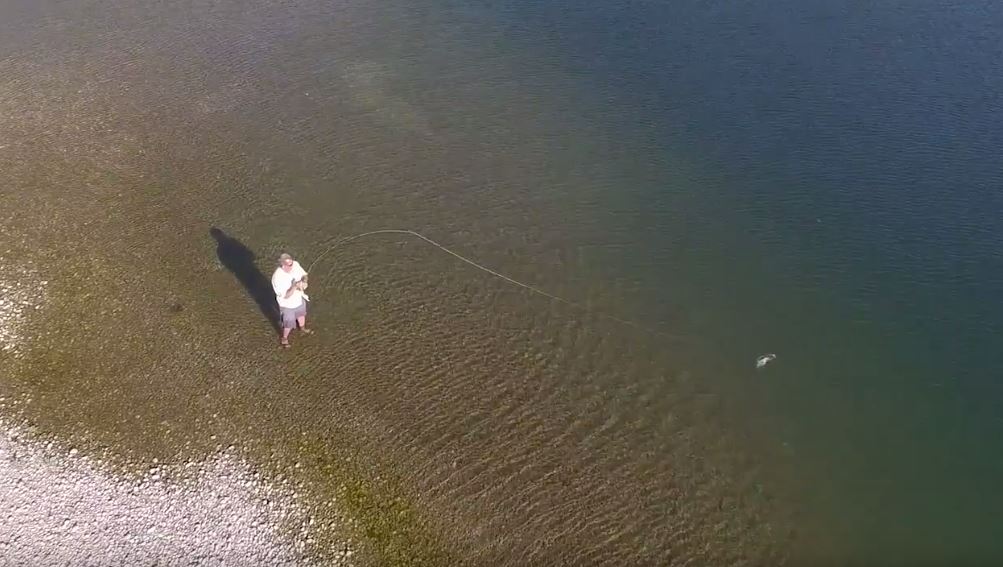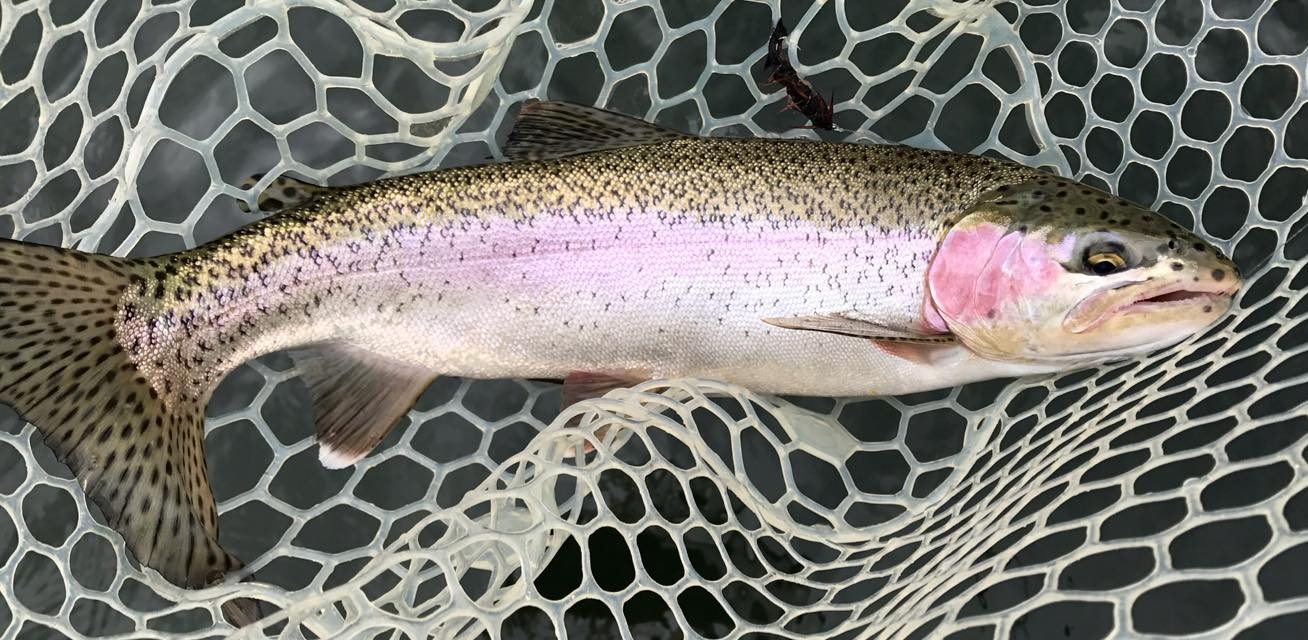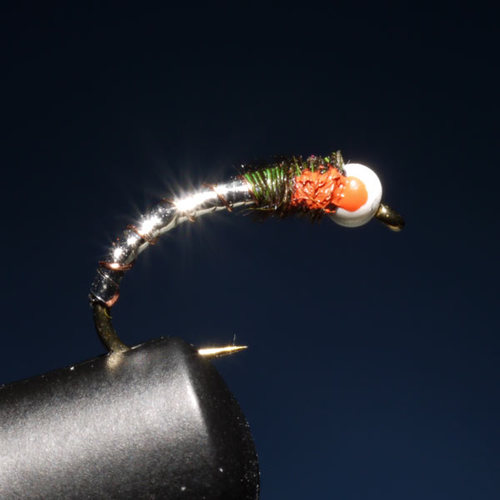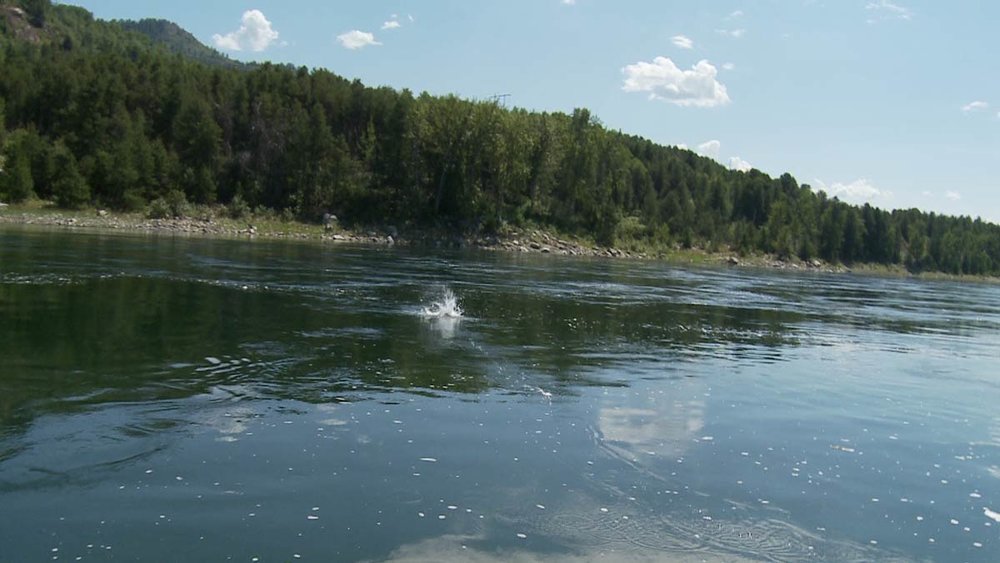Aquatic entomology is one of the most important aspects of fly fishing that both lake and stream anglers will be exposed to and learn from. This is a huge subject that one could literally study throughout their entire angling life. However, it is essential that we are at least able to identify those insects that are important trout food and that we also have a basic understanding of the insect’s life cycle and habitat preferences. An integral part of the aquatic entomology subject is recognizing how the various insect life stages move through the water and then applying that information to the way in which we present and/or retrieve our flies.
In streams, much of the aquatic insect life are able to utilize the current to move or drift them as they complete emergence cycles or simply move from one type of habitat to another. In lakes, the larval, nymphal and pupal stages of insects must propel themselves to locate food, avoid predators or reach the surface in order to emerge into the adult form. One of the ways fish recognize prey items is by the unique swimming or movement actions displayed by the food source. Let’s take a closer look at how the various life stages of the important aquatic insect orders move. Keep in mind that these are staple food sources for trout and other fish species found throughout the stillwater world.
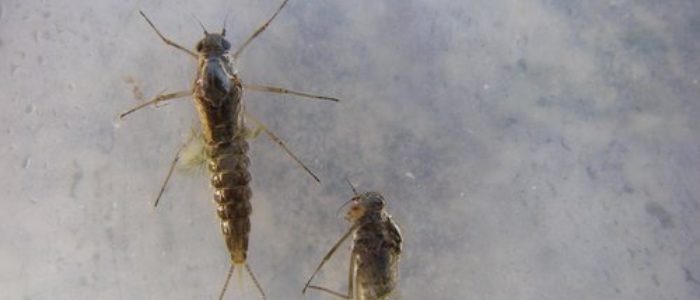
Damselflies and dragonflies of the Order Odonata are active swimmers while in the nymphal stage. Damselfly nymphs utilize a 3 lobed set of caudal lamellae or abdominal gills to propel them in a fairly slow, sinusoidal or snake-like motion through the water. They will swim for 3 to 8 inches; pause for up to a couple of seconds then resume moving. Fully developed nymphs swim more continuously as they urgently search out emergent plant stems to crawl up onto and complete the transformation to the adult stage. Dragonfly nymphs swim by venting water through the tip of their abdomen. This action gives the nymph a short, 3 to 5 inch quick burst of speed. Nymphs can sustain several of these fast movements in succession prior to taking a brief rest. In most situations dragonfly nymphs are happy to be crawling along the vegetation or lake bottom in search of food and usually only employ the “jet propulsion” swimming system to avoid predators.
Caddisflies (Order Trichoptera) undergo a complete metamorphosis or life cycle. Most species inhabiting stillwaters belong to the case maker group. These larvae live within a case which is built from bits of vegetation, particles of sand or other debris. Larvae move by using their 3 pairs of legs to crawl and pull their case slowly along the lake bottom and amongst the aquatic vegetation. Their cases leave telltale tracks in the marl or mud flats that cover shoal areas of the lake. Caddis pupa develop within the larval case. The fully developed pupae break out of theirlarval cases and swim quickly to the surface of the lake. Their ascent is aided by an elongated and feathered hind pair of legs which act as oars to quickly move them through the water. Pupae are often swimming up through 20 feet of water and are thus extremely vulnerable to predation by fish. The adult emerges from the pupal stage as soon as the pupa breaks the surface film. The actual pupal swimming action consists of relatively fast 3 to 6 inch long movements followed by brief pauses.
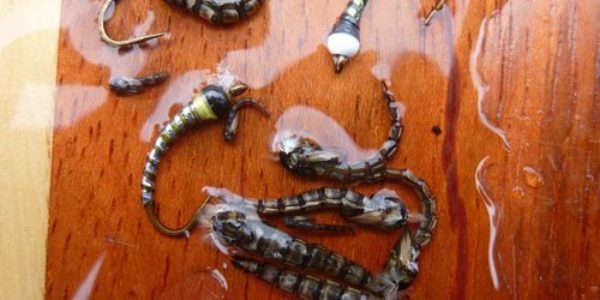
Mayflies (Order Ephemeroptera) are another common inhabitant of productive stillwaters. Most lake dwelling species are good swimmers that are capable of fairly quick but short bursts of speed. Developing nymphs seek food and cover amongst the vegetation growing up from the shallow shoal areas of the lake. When mature, the nymphs will swim to the surface to emerge into the dun or non-reproductive adult stage. The mature nymphs typically swim on a 20 to 30 degree angle to the surface of the lake. They swim in a sinusoidal motion in moderately fast 2 to 4 inch bursts. The nymphs will rest or pause regularly during their ascent. Once at the surface, a split forms along the back of the nymphal shuck to allow the adult form to emerge
Midges of the Order Diptera are unquestionably the most diverse group of insects inhabiting fresh water. A typical small productive lake in western North America could be host to literally a hundred different species. Midges or chironomids also undergo a complete metamorphosis or life cycle. Larval and pupal stages are poor swimmers but both require an ability to move in order to complete their respective life stages. Most stillwater midge larvae live in the benthic or bottom substrate of the water body. In many instances the larvae construct simple “mud tubes” in which they peer out from to feed on detritus. Larvae do leave their tubes in search of more ideal habitat and in other instances can be swept out of their tubes by strong currents formed during a turnover event or a rapid fluctuation of water levels. In either case the movement of the larvae is restricted to an ineffective wiggling motion. Midge pupa typically develop within the larval tube. Fully developed pupa exit the larval tube and ascend vertically to the surface of the lake. The pupa do not actually swim but wiggle and squirm up through the water. Their ascent is aided by gases trapped beneath the pupal shuck. Often, movement is rather rapid during the last couple of feet before reaching the surface. It is not uncommon for pupa to ascend through 40 feet of water making it a very slow and vulnerable emergence process.
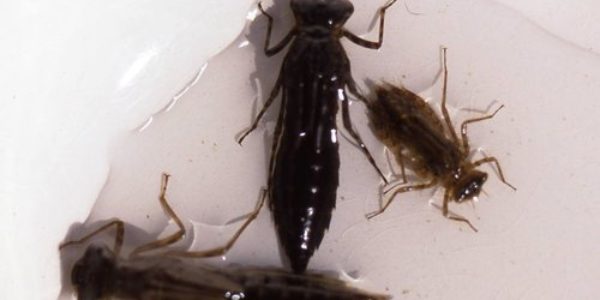
STILLWATER RETRIEVES
Overall, the movement of these aquatic insects is slow or at best they can move at a moderate speed for a very short distance. Some, like midges only rise or elevate through the water column. It can be hard for many anglers to slow their retrieves down and then maintain the slower pace long enough to effectively retrieve the entire length of a cast.
The strip and hand twist are two basic retrieves that all stillwater fly fishers should be comfortable using with the various food sources being imitated. The strip retrieve is as simple as it sounds and it is the basic retrieve for almost all fly fishing situations. The rod hand lightly pinches the fly line between the thumb and index (first) finger while the retrieve hand uses the same two fingers to pull or strip in a set amount of fly line. It takes a lot of practice to conduct a 4 inch slow strip retrieve cast after cast for several hours but if that is how the damselfly nymphs are swimming then it is best to go with the flow. Without patience and practice, those 4 inch strips soon become 8 then 12 inch pulls!
How slow is slow? For instance, to imitate a slow 2 inch strip retrieve count up to 2 seconds while the 2 inches is being retrieved. A fast 4 inch retrieve would count between 1 and 1.5 seconds per strip. Caddis pupa probably swims the fastest of these aquatic insect food sources. A fast 6 inch strip retrieve should take approx. 2 seconds to complete.
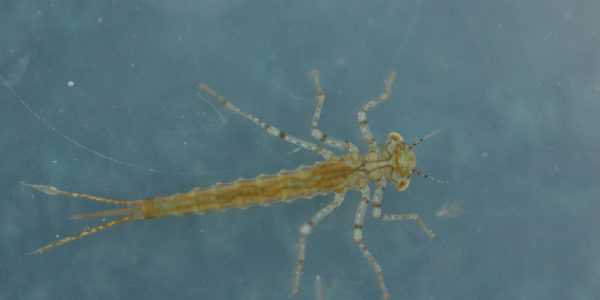
The hand twist is the other basic retrieve that should be mastered by all stillwater fly fishers. This is a busy retrieve, meaning that it requires more hand movement while at the same time helps to slow down the retrieve. The other advantage of this technique is that the angler has more control over the retrieve as the retrieve hand is always in contact with the fly line. The rod and retrieve hand start off in the same positions as the strip retrieve. The fly line is pulled down by the thumb and index finger of the retrieve hand while at the same time rotating the retrieve hand wrist outward thus leaving an open palm. The fly line is then hooked around the bay finger of the retrieve hand and then brought back to the thumb and index finger. This completes a full hand twist. As the maneuver is repeated coils of line will collect in the palm of the retrieve hand. It is best to release the fly line after 2 or 3 coils have accumulated. The hand twist is certainly the preferred retrieve to use when imitating the midge pupa either rising up through the water column or very slowly moving the pupal pattern horizontally through the water. In these instances a complete hand twist could take upwards of 8 seconds to complete.
The strip and hand twist retrieves will allow the angler to match the movement of these essential stillwater food sources. It can also be beneficial to impart a bit of irregular movement to your fly as it is being retrieved. In other words, try adding several very short, quick one inch strips in succession during any normal strip or hand twist retrieve. I routinely mix in 3 or 4 of these quick strip tactics into any stillwater retrieve. Sometimes this off tempo movement is enough to commit an otherwise slightly sceptical trout into taking the fly.
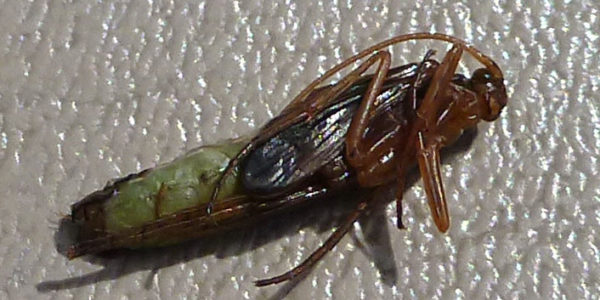
Wind drifting from an anchored boat is also an effective technique to present flies being fished with floating fly lines. It is used most commonly with mayfly nymphs, damselfly nymphs, caddis pupa and midge pupa. Although technically not a retrieve, wind drifting takes advantage of gentle wind conditions to naturally move the sunk fly in a subtle undulating motion horizontally through the water column. A cast is made sideways or perpendicular to the direction of the wind. A large arching bow develops in the fly line as the waves carry it downwind. The length of the leader and weighted versus un-weighted flies determine where in the water column the fly will travel. Make sure the rod is secure when using this tactic!!
It takes practice in order to get comfortable with these retrieves. While on the water watch for the real insects and note their swimming and movement patterns. That will be the best check as to how realistic your retrieves are being conducted.
-
 Read more +
July 19, 2024 By Don Freschi in Fly Tying, Member Content, New Blog Posts, On The Bench, Series 28 On the Bench, Tips & Techniques, Video Posts
Read more +
July 19, 2024 By Don Freschi in Fly Tying, Member Content, New Blog Posts, On The Bench, Series 28 On the Bench, Tips & Techniques, Video Posts
The Simple Zucchini Chironomid
-
 Read more +
By Don Freschi in Fly Tying, Member Content, New Blog Posts, On The Bench, Series 28 On the Bench, Tips & Techniques, Video Posts
Read more +
By Don Freschi in Fly Tying, Member Content, New Blog Posts, On The Bench, Series 28 On the Bench, Tips & Techniques, Video Posts
Don’s Nightmare Jig Leech
-
 Read more +
By Don Freschi in Fly Tying, Member Content, New Blog Posts, New Episodes, On The Bench, Series 28 Shows, Tips & Techniques, Video Posts
Read more +
By Don Freschi in Fly Tying, Member Content, New Blog Posts, New Episodes, On The Bench, Series 28 Shows, Tips & Techniques, Video Posts
Stoney Lake Chironomids – Show #11 of Series 28
-
 Read more +
July 8, 2024 By Don Freschi in Fly Tying, Member Content, New Blog Posts, New Episodes, On The Bench, Series 28 Shows, Tips & Techniques, Video Posts
Read more +
July 8, 2024 By Don Freschi in Fly Tying, Member Content, New Blog Posts, New Episodes, On The Bench, Series 28 Shows, Tips & Techniques, Video Posts
Dry Flies on Dragon Lake – Show #10 of Series 28
-
 Read more +
June 29, 2024 By Don Freschi in Fly Tying, Member Content, New Blog Posts, New Episodes, On The Bench, Series 28 Shows, Tips & Techniques, Video Posts
Read more +
June 29, 2024 By Don Freschi in Fly Tying, Member Content, New Blog Posts, New Episodes, On The Bench, Series 28 Shows, Tips & Techniques, Video Posts
Dry Fly Caddis – Show #9 of Series 28
-
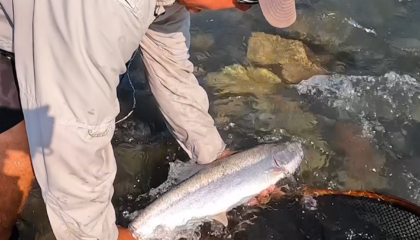 Read more +
April 20, 2024 By Don Freschi in Member Content, New Blog Posts, New Episodes, Series 28 Shows, Tips & Techniques, Video Posts
Read more +
April 20, 2024 By Don Freschi in Member Content, New Blog Posts, New Episodes, Series 28 Shows, Tips & Techniques, Video Posts
Sink Tips on the Skeena River

